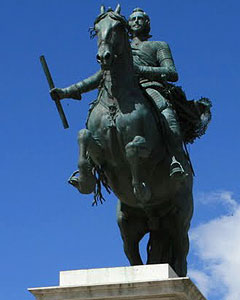Bronze

Bronze is a metal made from the combination of copper and aluminum. Its natural color is golden, but it can also have other colors, which are achieved under the effects of liquid chemicals (skids) that work like paint. These can be black, brown, yellow, red, green, etc. They can also have a natural shine.
It is the material most often used for sculpture thanks to its properties: it is resistant, strong, flexible, sustainable (lasts forever) and allows you do make very delicate things, like a tree leaf, and at the same time strong and able to withstand a lot of weight. For example, it could be an enormous horse jumping on two thin legs that can hold it up perfectly, like in the statue shown on the photo (this statue is in front of the Royal Palace in Madrid, Spain, and represents the king Felipe IV).
A bronze work is complicated, it requires teamwork: sculptor, molding and casting specialist, chisel assembly (I am also a specialist) and additional details, until the work is ready for presentation. For these reasons bronze sculpture is expensive but pretty and eternal. It is an object of great value.
Sometimed sculpture materials are combined with very good results. An example of this is the monument La Gloria de los Pegasos in Madrid, where bronze and marble are masterly employed.
Marble
For thousands of years, great sculpture masters have used marble as the principal material due to its beauty and natural purity. The great Italian sculptor Michelangelo made almost all of his work with carrara white marble and achieved spectacular effects, attaining perfection in the smallest detail.
Creating a marble sculpture takes a lot of work and a high profession level. The cost is slightly higher than for bronze. Marble can be of many types: pure white, white with gray stripes, red, brown, black, with drawings, and many other varieties. You can choose depending on the environment. Sculpture made from this material can be beautiful thanks to its natural color and brightness and because its authenticity always attracts.
Madrid exhibits a wealth of scultpures, monuments and fountains made of marble and other kinds of stone. A noteworthy example of what can be achieved with marble is La Fuente de las Conchas, located by the Palacio Real.
Terracotta (clay)
This material is more economical because it does not require as many technical impediments. Here are only the clay and the artist. Terracotta is very pretty and can be various colors: white, red, brown. It can also be colored to have a natural shine. The color of clay is hot and is a pleasure to the eye. It is a perfect decoration of high quality.
Madrid is also a good place to admire terracotta sculptures, especially in its many churches.
Gypsum (plaster)
It is a completely white material and rigid media. It is mixed with water and is worked on when wet. Once mixed, after an hour it is dry and hard. It is used for decoration when promptness is needed and it is very economical. It can be used to design reliefs on the walls and make copies in bulk for sculptures, vases, etc. It can also be painted.
Many buildings in Madrid, old and modern, feature a rich display of plaster reliefs in their interiors.
Wood
Woodwork, just as marble, is exclusive and unique, and requires a high level professional artist. Wood has always been a special decoration, familiar and personal, especially in country houses. Its texture is unique; it appears live and breathing. It cannot be confused with other materials and its authenticity is notable.
Wooden sculpture keeps a home warm and brings luck. It can be covered with varnish and tinged with different colors: brown, red, black, etc.